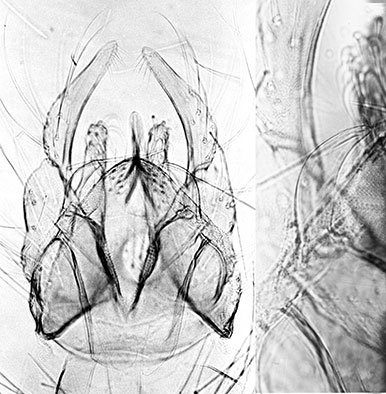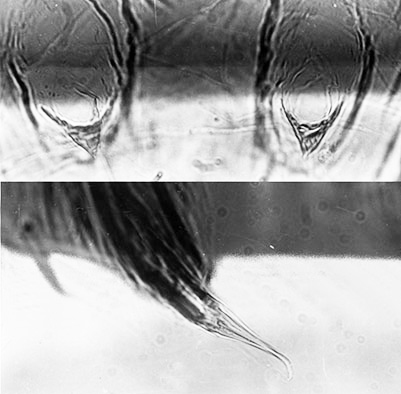Species u. C. nr. tuxis.For C. tuxis Curran, see Species 4o. This species is closely related to C. species 2u.
There is no BARCODE sequence matching that of this species currently in the BOLD database.Adult The adults and pupal exuviae of this species are in the Sublette Collection, now in the museum at the University of Minnesota, St. Paul, MN.
Only the male terminalia can be given here.
Males:

Male terminalia (left) and superior volsella (right) of C. sp. nr. tuxis.About 5 setae in patch on tergite IX. Superior volsella closest to E(g)-type of Strenzke (1959). Inferior volsella extending almost to end of anal point and !/3 to 1/2 way along the gonostylus which narrows gently over posterior half. Anal point appears narrowed at base. Pupa: Cephalic tubercles relatively small, postero-lateral spur with 1-2 long closely applied spines and possibly a shorter one arising lower down the spur. 
Pupal cephalic tubules (above) and spur (below) of C. sp. nr. tuxis.Fourth instar larva a medium sized plumosus-type; length 10.5-12.2 mm (single male 10.5 mm; female 12.2 mm). Specimens from Manitoba smaller than those from Alberta (perhaps because the Alberta specimens are from an eggmass reared under laboratory conditions). Lateral tubules about 244 (200-250) µm; anterior Ventral tubules 1.0-1.48 mm, shorter than the posterior pair (1.18-1.76) mm). Anal tubules a single lobe, ventral pair 399 (280-505) µm, usually longer than dorsal pair 379 (240-455) µm, and 2-3.5 times longer than wide.Gula region broadly darkened but less in mid line (as in C. staegeri) and widest about a third up from posterior margin; ; frontoclypeus with a thick dark stripe (also in species 2u).
Ventral Head Length about 369.5 (368-371) µm (female) and 325.5 (318-333) µm (male).
Mentum (Fig. c) with 4th laterals reduced almost to level of 5th laterals (type I-II) median tooth with c2 teeth quite well separated (type IB in Alberta but type IIA or III in Manitoba - differential wear?).
Salivary reservoir 81.7 (73-94) µm long and 3.7-5.3 times longer than wide.
Ventromental plates (Fig. d) about 220.8 (205-232) µm, 3.65 (3.3-4.0) times longer than deep; with about 45.9 (41-52) striae; VMR about 0.37 (0.35-0.40); separated by about 0.28-0.4 of mentum width. Pecten epipharyngis (Fig. a) with about 12.8 (11-16) relatively broad teeth (i.e type C).
Premandible with inner tooth relatively broad, 3.5-5 times wider than the outer tooth which narrows to a sharp point, while inner tooth narrows to a broad point (Type C).
Antenna (Fig. b) with basal segment about 0.33-0.40 of Ventral Head Length and 2.8 (2.3-3.4) times as long as wide; AR about 1.87 (1.62-2.14); Ring organ about 0.35-0.48 up from base of segment; antennal segments (micron) 127 : 36.5 : 11 : 13 : 9. Segment A1 sometimes quite wide, but this may be due to being squashed onto slide during mounting.
Distance between antennal bases (106-170 µm) less than that between S4 setae (142-192 µm), which occupy 87.5 (81-92)% of the frontoclypeus width. S5 setae level or slightly posterior to the nearby RO.
Mandible (Fig. e) with 3rd inner tooth lightly coloured and mostly partially separated (type I-IIB); about 21.1 (18-24) furrows on the outer surface near the base; and 12 (11-14) taeniae in Pecten mandibularis; Mdt-Mat 28-35 µm, MTR 0.35 (0.29-0.44). Cytology: 4 relatively short polytene chromosomes with the thummi arm combination AB, CD, EF, G.
Arm G short and generally paired only at the virtually terminal nucleolus, often end-to-end. No nucleoli in the longer chromosomes.
Puff (groups 7-8) in arm B near end of arm, with distal dark bands.
No inversion polymorphism in the available specimens.
The chromosome preparations are not clear because they are quite contracted, but it is possible that many sequences are the same as those of C. species 2u, while arm G is much shorter.
Arm A; Possibly as C. sp. 2u.
Arm B: Likely an inversion of the distal part of the arm.
Arm C: Possibly as C. sp. 2u.
Arm D: Possibly as C. sp. 2u.
Arm E: Possibly 1 - 3e, 10b - 3f, 10c - 13
Arm F: Possibly as C. sp. 2u.
Arm G does not always show end to end pairing at the nucleolus Found in a large pool with mud bottom at depth of about 60 cm.Found: Alberta - Huntington Hills, Calgary (51.08°N, -114.08°W).
Manitoba - 6.7 ml s. Erickson (50.48°N, -99.90°W). Molecular data:
MtCOI: Sequence has been obtained from only 1 larva from Manitoba but, as noted above, there is no matching sequence in BOLD or GenBank. [ Return to Index| Go to References ] |

